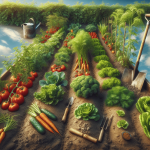This post may contain affiliate links. As an Amazon Associate, we may earn commissions from qualifying purchases.
Have you ever pondered how the unpredictable whims of climate change might affect your backyard haven? Your garden, that patch of Earth you’ve so lovingly cultivated, faces new challenges as extreme weather becomes the norm. Creating a resilient garden can be a daunting prospect, but with a little know-how and some intentional planning, you can nurture a space that thrives despite climate uncertainties. Let’s have a chat about how you can turn your garden into a sustainable sanctuary.
Understanding the Impact of Climate Change on Gardening
Before digging in—both figuratively here and literally out there—let’s get a grasp on how climate change is affecting landscapes. Changes in weather patterns bring about more frequent droughts, increased rainfall, and fluctuating temperatures that challenge traditional gardening practices. Understanding these impacts is the first step in adapting your garden.
The New Weather Norms
You may have noticed warmer winters and hotter summers, with dry spells where rain was once plentiful. These shifts require you to reconsider plant choices and gardening techniques. Traditional plants might not fare as well under these new conditions.
Soil Health and Water Availability
Climate change also affects soil fertility and water resources, two fundamental elements for a thriving garden. Dry spells can lead to nutrient-depleted soil, while excessive rain can cause erosion, washing away valuable topsoil.
Designing with Resilience in Mind
Now that you’re up to speed on the challenges, let’s talk about designing for resilience. A climate-resilient garden isn’t just about picking the right plants; it’s about smart planning.
Choosing the Right Plants
Opt for plants that can withstand the challenges of your changing local climate. Native species are often the best bet as they’re already adapted to the local environment, but you might also consider drought-tolerant or heat-resistant varieties.
Diversifying Plant Selection
A diverse garden is a resilient garden. By including a mixture of species, you reduce the risk of losing all plants to a specific pest or extreme weather condition. Think of your garden like a restaurant menu—variety keeps things interesting and safe.
Strategic Plant Placement
Plan your garden with microclimates in mind. Place shade-loving plants where they’re protected from the harsh midday sun and drought-tolerant plants in sunnier spots. Understanding the unique conditions of your garden helps in making smarter choices.

Soil Management for Longevity
You might not see it instantly, but soil is the lifeblood of your garden. Healthy soil is critical for the plants’ well-being, especially in a changing climate.
Composting and Mulching
Composting and mulching enrich the soil with organic matter, improve water retention, and regulate temperature. Plus, they’re fantastic ways to recycle kitchen and garden waste—talk about a win-win!
No-Till Gardening
Consider adopting a no-till approach to reduce soil disturbance. This method helps maintain the soil structure, minimize erosion, and promote healthy microorganisms crucial for plant health.
Water-Wise Practices
Water might be coming in abundance one moment and scarcity the next. Developing smart water management strategies is essential for the resilient garden.
Rainwater Harvesting
Installing rain barrels or a more elaborate rainwater catchment system can help you store rainwater for dry spells. Using rainwater is not only eco-friendly but can also cut down on your water bill.
Drip Irrigation
Drip irrigation is efficient, directing water straight to the plant roots where it’s needed most. It reduces water waste and ensures your plants get just the right amount of hydration.

Supporting Local Wildlife
A resilient garden supports not only plants but also the wildlife that plays a crucial role in the ecosystem. Beneficial insects and birds can be your garden allies.
Creating Habitats
Provide habitats such as birdhouses, bee hotels, or simple piles of rocks and logs. These will encourage the presence of pollinators and predators that keep pest populations in check, fostering a balanced ecosystem.
Avoiding Pesticides
Pesticides can harm beneficial insects and disrupt ecological balance. Instead, opt for natural solutions like neem oil or introduce ladybugs to control aphid populations.
Emphasizing Sustainability
The essence of a climate-resilient garden is sustainability. Small changes in your gardening practices can make significant impacts.
Organic Practices
Going organic by using natural fertilizers and pesticides not only protects the environment but also enhances soil health and plant resilience. Compost, manure, and green manures are excellent organic options.
Reducing Carbon Footprint
Consider manual tools over powered ones to reduce greenhouse gas emissions. Electric tools powered by renewable energy sources are also more sustainable options if a powered tool is necessary.
Learning and Adapting
Resilience isn’t set in stone; it’s about learning and adapting to change. Gardening is a continual process of observation and adjustment.
Keeping a Garden Journal
Document your garden’s progress, noting what thrives and what doesn’t. A garden journal helps you track changes and make informed adjustments to your gardening practices.
Community and Resources
Join local gardening communities or online forums where you can share tips and learn from others facing similar challenges. There’s a vast world of knowledge out there, ready for the sharing.
Conclusion: Your Garden’s Resilient Future
As you reassess your garden’s needs in the face of climate change, think of this challenge as an opportunity to innovate and grow as a gardener. With thoughtful planning, sustainable practices, and a bit of trial and error, you can cultivate a garden that not only survives but thrives in our changing world. Nurture your connection with nature and adapt your strategies as the climate shifts, ensuring your garden remains a cherished sanctuary for years to come.








